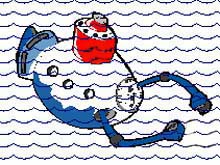
During this expedition scientists and students from eight different institutions in the U.S., Norway, England, Portugal and Spain will be studying the reproduction and embryology of seep animals, including mussels, clams, snails, crustaceans, tubeworms and several other kinds of worms.
Education
Read a description of each lesson plan and/or download them to your computer.
With the establishment of the Ocean Exploration Program within the National Oceanic and Atmospheric Administration (NOAA), we can reach out in new ways to teachers, students, and the general public and share the excitement of daily discoveries while at sea.
One of the major surprises of deep-sea biology in the past 50 years has been the discovery that many species living in deep cold waters breed during only one season of the year. Although seasonal breeding is common in shallow water, it is unexpected in the deep sea, where seasonal changes are not obvious. The focus of the Gulf of Mexico Expedition (Leg 3) is to study the reproduction and embryology of seep animals, including mussels, clams, snails, crustaceans, tubeworms and several other kinds of worms.
During the expedition, an interdisciplinary team of scientists will use the Harbor Branch Oceanographic Institution’s submersible, the Johnson Sea-Link-II and will sail on the 204-ft. research vessel Seward Johnson to study cold seep communities in the Gulf of Mexico. They seek to understand the signals that tell deep-sea animals when it is time to reproduce. The scientists plan to study feeding biology and community stucture and diversity, rear microscopic larvae, and collect sediment cores .
Educators and scientists working with NOAA during September and October 2002 developed a series of lesson plans for students in Grades 5 through 12 that are specifically related to the Gulf of Mexico Expedition. The lesson plans focus specifically on the importance of ocean exploration and the research taking place during the Gulf of Mexico Expedition, and feature such topics as symbiotic relationships in cold-seep communities, succession in chemosynthetic communities, predator-prey relationships, deep-sea habitats, and general ecology and reproductive strategies at cold-seep sites.
The lesson plans are grouped into the following categories:
Grades 5-6
Grades 7-8
Grades 9-12 (chemical, biological, earth, and physical science).
Sign up for the Ocean Explorer E-mail Update List.























